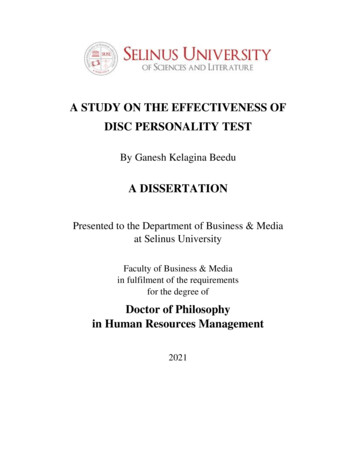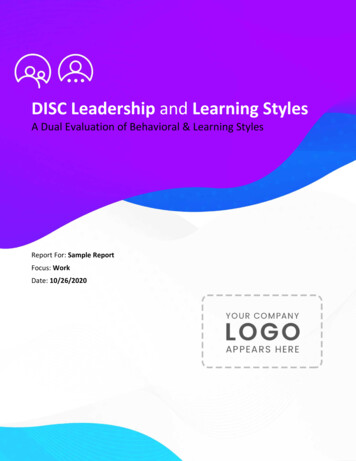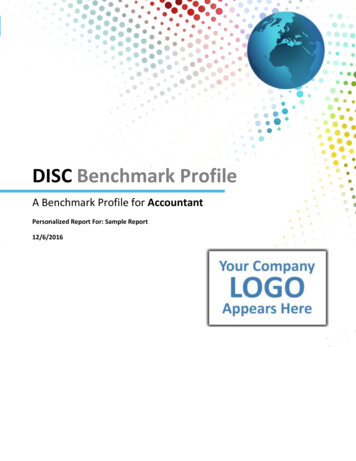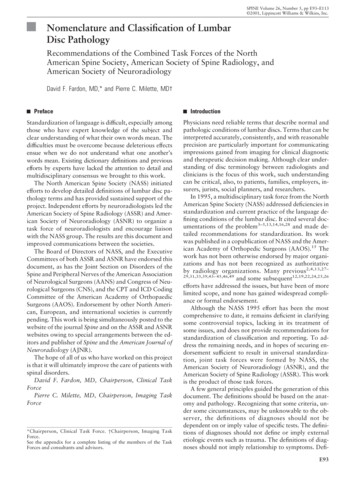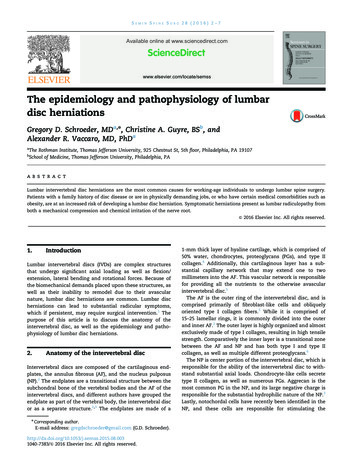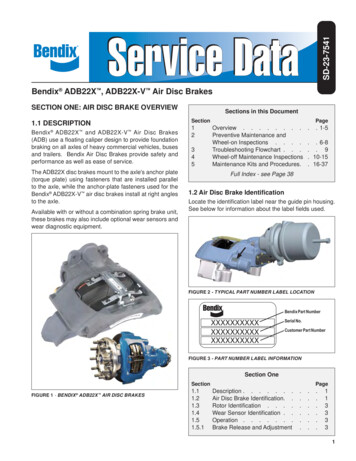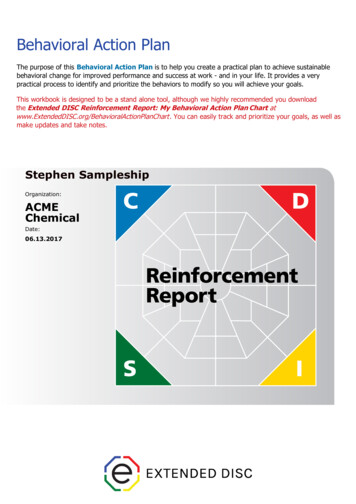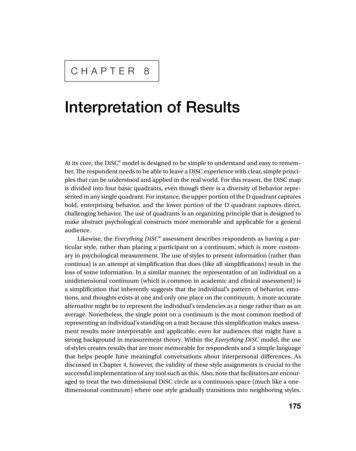
Transcription
DISC LeadershipREPORT FOR Sample Report - IC/D STYLEDISC LeadershipAn Evaluation of Behavioral StylesReport For: Sample ReportStyle: IC/DFocus: WorkDate: 10/23/2019Copyright 2020 A24x7.All rights reserved.Company Name Here 206-400-6647 www.YourWebsite.com1
DISC LeadershipREPORT FOR Sample Report - IC/D STYLETable of ContentsIntroduction to the DISCstyles Online Report .3PART I Understanding DISCBehavioral Styles Overview .4Pace and Priority of Each Style .5A Deeper Look at the Four DISCStyles .6Communicating with the DISCStyles.7PART II Understanding YourselfGeneral Characteristics.9Your Style Overview.10Word Sketch: Adapted Style.11Word Sketch: Natural Style.12Your Personalized eGraphs.13Your Behavioral Pattern View.14Communication Tips for Others.15Your Motivations: Wants and Needs.16What You Bring to the Organization.17Your Behavior and Needs Under Stress.18Potential Areas for Improvement.19The 12 Behavioral Tendencies .20Summary of Your Style .25PART III Understanding Others and AdaptabilityIntroduction.26What is Adaptability? .27Recognizing Another Person’s Behavioral Style .28Communicating with Each Style .29Tension Among the Styles .29To Modify Directness and Openness .30To Modify Pace and Priority .31Adapting in Different Situations .32Application Activities .36Building and Maintaining Rapport Throughout The Leadership Process .39So Now What? .54Why is Independently Tested Accuracy of this Assessment Important?A recent review revealed a significant majority of assessments available todaywere absent the studies & reporting to confirm their accuracy. Of the smallminority which claimed reporting, the significant majority of those were conductedprivately; oftentimes by the assessment provider itself, rather than an objectiveand scientifically qualified third party. However, we are leading by example in thisotherwise unregulated industry. How are we doing this? By submitting ourassessments to an objective, independently conducted battery of tests: ConstructValidity, Reliability, and Disparate Impact - all by a qualified scientific authority(Assessment Standards Institute). Our goal? Ensuring the trust and confidence ofour users by producing the industry’s most accurate and class protectedassessments. Please turn to the last page of this report to learn more on this topic,and the steps we’ve taken to safeguard the scientific accuracy of this assessment.Copyright 2020 A24x7.All rights reserved.Company Name Here 206-400-6647 www.YourWebsite.com2
DISC LeadershipREPORT FOR Sample Report - IC/D STYLEWelcome to the DISCstyles Online ReportINTRODUCTIONDISC is a simple, practical, easy to remember and universally applicable model. It focuses on individual patterns ofexternal, observable behaviors and measures the intensity of characteristics using scales of directness andopenness for each of the four styles: Dominance, Influence, Steadiness, and Conscientious.Using the DISC model, it is easy to identify and understand our own style, recognize and cognitively adapt todifferent styles, and develop a process to communicate more effectively with others.HOW TO USE THIS REPORTThe DISC report is divided into 3 parts introducing the DISC model, helping you understand your own style, andidentifying ways that you can apply your style strengths or modify your style weaknesses in order to meet theneeds of others. Part I focuses on understanding each of the DISC styles and identifying characteristics, including thetendencies of each behavioral style Part II is about understanding yourself and will reveal information about the tendencies that make youunique Part III examines and explores adaptability and offers actionable recommendations for you and otherswho interact with youWith this personalized and comprehensive report, DISC gives you tools to help you become a better you - todevelop and use more of your natural strengths while recognizing, improving upon, and modifying your limitations.Then, because we can easily see and hear these behaviors, we can quickly and accurately “read” other people anduse our knowledge to enhance communication and grow our relationships.Please Note: Any behavioral descriptions mentioned in this report are only tendencies for your style group andmay or may not specifically apply to you personally.Copyright 2020 A24x7.All rights reserved.Company Name Here 206-400-6647 www.YourWebsite.com3
DISC LeadershipREPORT FOR Sample Report - IC/D STYLEPart I Understanding DISCBEHAVIORAL STYLESHistorical and contemporary research reveal more than a dozen various models of our behavioral differences, butmany share one common thread: the grouping of behavior into four basic categories.The DISC styles are Dominance, Influence, Steadiness, and Conscientious. There is no “best” style. Each style hasits unique strengths and opportunities for continuing improvement and growth.The DISCstyles assessment examines external and easily observable behaviors and measures tendencies usingscales of directness and openness that each style exhibits.BEHAVIOR DESCRIPTORS OF tivePersistentAdventurousProblem SolverResults gSTEADINESSUnderstandingFriendlyGood ListenerPatientRelaxedSincereStableSteadyTeam PlayerDIRECTNESS AND OPENNESS OF EACH STYLECopyright 2020 A24x7.All rights reserved.Company Name Here 206-400-6647 lyticalCompliantCourteousDiplomaticDetailedFact FinderObjectivePACE AND PRIORITY OF EACH STYLE4
DISC LeadershipREPORT FOR Sample Report - IC/D STYLEPACE AND PRIORITY OF EACH -ORIENTEDPACE AND PRIORITY represent two of the main sources of tension between the styles. D&C and I&S have different PACES: D and I are faster-paced, and S and C are slowerpaced. D&I and S&C have different PRIORITIES: D and C are task-oriented, and I and S arepeople oriented. D&S and I&C have BOTH PACE AND PRIORITY DIFFERENCES.Copyright 2020 A24x7.All rights reserved.Company Name Here 206-400-6647 www.YourWebsite.com5
DISC LeadershipREPORT FOR Sample Report - IC/D STYLEA DEEPER LOOK AT THE FOUR DISCStyles Below is a chart to help you understand some of the characteristics of each of the Four Basic DISC Styles, so youcan interact with each style more effectively. Although behavioral style is only a partial description of personality,it is quite useful in describing how a person behaves, and is perceived, in personal, social and work GHSTEADYSTYLEHIGHCONSCIENTIOUSSTYLETends to ActAssertivePersuasivePatientContemplativeWhen in Conflict, thisStyleDemands tineStandardsPrimary eferred TasksChallengingPeople relatedScheduledStructuredBeing decisiveSocial friendlinessBeing part of ateamOrder and planningPersonal StrengthProblem ndedPreoccupation ongoals over peopleSpeaking withoutthinkingProcrastination inaddressing changeOver analyzingeverythingPersonal LimitationToo direct andintenseToo disorganizedand nontraditionalToo indecisive andindirectToo detailed andimpersonalPersonal WantsControl,VarietyApproval,Less tionSudden ChangeBeing WrongBlind SpotsBeing heldaccountableFollow through oncommitmentsEmbracing needfor changeStruggle to makedecisions withoutoveranalyzingNeeds to Work onEmpathy,PatienceControllingemotions FollowthroughBeing assertivewhen pressuredWorrying less abouteverythingGiving up controlObjectively handlingrejectionStanding up forself whenconfrontedNot being defensivewhen criticizedUnder Stress bmissiveIndecisiveWithdrawnHeadstrongMeasures Worth byImpact or resultsTrack ibutionsPrecision, AccuracyQuality of resultsComfortable withPersonal FearMeasuring MaturityCopyright 2020 A24x7.All rights reserved.Company Name Here 206-400-6647 www.YourWebsite.com6
DISC LeadershipREPORT FOR Sample Report - IC/D STYLECOMMUNICATING WITH THE DISCStyles Communicating with the DOMINANT StyleD CHARACTERISTICS:Concerned with being #1Think logicallyWant facts and highlightsStrive for resultsLike personal choicesLike changesPrefer to delegateWant others to notice accomplishmentsNeed to be in chargeTendency towards conflictSO YOU SHOULD Show them how to win, new opportunitiesDisplay reasoningProvide concise dataAgree on goal and boundaries, the support or get out of their wayAllow them to “do their thing,” within limitsVary routineLook for opportunities to modify their workload focusCompliment them on what they’ve doneLet them take the lead, when appropriate, but give themparametersIf necessary, argue with conviction on points of disagreement,backed up with facts; don’t argue on a “personality” basisCommunicating with the INFLUENCING StyleI CHARACTERISTICS:Concerned with approval and appearancesSeek enthusiastic people and situationsThink emotionallyWant to know the general expectationsNeed involvement and people contactLike changes and innovationsWant others to notice THEMOften need help getting organizedLook for action and stimulationSurround themselves with optimismWant feedback that they “look good”SO YOU SHOULD Show them that you admire and like themBehave optimistically and provide upbeat settingSupport their feelings when possibleAvoid involved details, focus on the “big picture”Interact and participate with themVary the routine; avoid requiring long-term repetition by themCompliment them personally and oftenDo it togetherKeep up a fast, lively, paceSupport their ideas and don’t poke holes in their dreams; showthem your positive sideMention their accomplishments, progress and your other genuineappreciationCopyright 2020 A24x7.All rights reserved.Company Name Here 206-400-6647 www.YourWebsite.com7
DISC LeadershipREPORT FOR Sample Report - IC/D STYLECommunicating with the STEADY StyleS CHARACTERISTICS:Concerned with stabilityThink logicallyWant documentation and factsLike personal involvementNeed to know step-by-step sequenceWant others to notice their patientperseveranceAvoid risks and changesDislike conflictAccommodate othersLook for calmness and peaceEnjoy teamworkWant sincere feedback that they’reappreciatedSO YOU SHOULD Show how your idea minimizes riskShow reasoningProvide data and proofDemonstrate your interest in themProvide outline and/or one-two-three instructions as youpersonally “walk them through”Compliment them for their steady follow-throughGive them personal assurancesAct non-aggressively, focus on common interest or neededsupportAllow them to provide service or support for othersProvide a relaxing, friendly atmosphereProvide them with a cooperative groupAcknowledge their easygoing manner and helpful efforts, whenappropriateCommunicating with the CONSCIENTIOUS StyleC CHARACTERISTICS:Concerned with aggressive approachesThink logicallySeek dataNeed to know the processUtilize cautionPrefer to do things themselvesWant others to notice their accuracyGravitate toward quality controlAvoid conflictNeed to be rightLike to contemplateSO YOU SHOULD Approach them in an indirect, nonthreatening wayShow your reasoningGive data to them in writingProvide explanations and rationaleAllow them to think, inquire and check before they makedecisionsWhen delegating, let them check procedures, and other progressand performance before they make decisionsCompliment them on their thoroughness and correctness whenappropriateLet them assess and be involved in the process when possibleTactfully ask for clarification and assistance you may needAllow them time to find the best or “correct” answer, withinavailable limitsTell them “why” and “howThe first step to building stronger communication is awareness. By identifyinghow we are similar and different, we can make cognitive choices wheninteracting to create stronger, more engaged relationships.Copyright 2020 A24x7.All rights reserved.Company Name Here 206-400-6647 www.YourWebsite.com8
DISC LeadershipREPORT FOR Sample Report - IC/D STYLEPart II Understanding YourselfGeneral CharacteristicsThe narration below serves as a general overview of your behavioral tendencies. It sets the stage for the report which follows,and provides a framework for understanding and reflecting on your results. We've occasionally provided some coaching ideas sothat you can leverage your strengths whenever possible to maximize your personal success.You are an excellent problem solver who can think quickly on your feet to solve problems that arise. You are able to do this dueto your rapid decisiveness, ability to multi-task, and your tendency to "blaze your own trail" rather than follow the beaten path.Be certain to involve others in the decision-making process, as an independent problem solver can sometimes be perceived as aproblem creator.Sample, you prefer a change-oriented environment and may become bored when the pace slows. You score like those who tendto have an appetite for new ideas and are attracted to challenges like a magnet. However, once the project is successfullylaunched, your attention may wander to new ventures.You tend to be more of a doer than a dreamer. Some people dream of making things happen, but you prefer to work hard toeffect change. If something needs to be done, you'll roll up your sleeves and do it.You are very direct and straightforward in communicating with others. You score like those who speak their minds, tell it like it is,and prefer bottom-line closure to ambiguity. You like to get things done quickly, and that includes conversations. You tend notto "sugar-coat" the message with unnecessary fluff.You are very self-reliant, and prefer to find your own solutions. You score like other independent people who may be considered"movers and shakers." This group tends to think quickly, decide quickly, and create opportunities and solutions where noneexisted before. All or much of this is done in a completely independent manner. That's a strength, for both you and yourorganization, as long as that strength is recognized.You score like those who speak their minds, and may be blunt, or even sarcastic. While this gets results, it can also alienatethose who are integrally important to the outcome. Our coaching suggests adopting a more people-friendly approach.You have many ideas and opinions of your own and a high degree of confidence in those ideas. It might be said that people whoscore like you tend to have a rather visible ego presence. However, those who are able to manage this can nevertheless thrive ina more people-friendly work climate.You are a strong self-starter who shows a high sense of urgency to get things done. now. This is a prominent theme in yourresponse pattern. Of all the behavioral styles, your response pattern tops the list for high urgency. The good news is that you'reusually the first to get service, to offer an idea, and usually the first to cross the finish line on projects. The flipside is that someof those who helped you along the way might feel as if they are forgotten. Don't forget to acknowledge those who assisted, asyou may require their assistance in the future.Copyright 2020 A24x7.All rights reserved.Company Name Here 206-400-6647 www.YourWebsite.com9
DISC LeadershipREPORT FOR Sample Report - IC/D STYLEStyle OverviewDISC describes you based on your observable behavior which can provide insights for others regarding yourcommunication preferences and how you will likely interact with and respond to them.Through this report you have an opportunity to discover (observe and evaluate) your behavioral responses invarious environments. You can explore your reactions to a variety of situations and contexts, including the actionsand reactions of others, to determine the most effective communication strategy or course of action.Your Behavioral Style: ProducerProducers follow their own path and will seek new projects and challenges. They are self reliant and like to solvetheir issues without asking for help. This independence fosters innovation that is strongly advocated to others.Being in control is important to them and they can push back if challenged. They have high expectations of othersand can be quite critical if expected results lag. They can be seen as uncaring and, at times, difficult to work with.Below are some key behavioral insights to keep in mind and share with others to strengthen your relationships. Emotional characteristic: Will strive to meet their own needs in their own way. Goals: Finding new opportunities they can tackle and goals to achieve. How others are valued: Based upon ability to create workable solutions that meet the Producer'sstandards. Influences group: Will influence by setting a competitive fast-paced agenda aimed at accomplishingresults and by projecting personal power. Value to the organization: Will avoid the "blame game" and will offer new and innovative solutionstowards making progress. Cautions: Can appear overly controlling of others and outcomes in order to support and meet their ownpersonal agendas. Under Pressure: Can become isolated and will push back hard if they are challenged or threatened or ifthey are denied new opportunities. Fears: Losing control or being without meaningful challenges.Copyright 2020 A24x7.All rights reserved.Company Name Here 206-400-6647 www.YourWebsite.com10
DISC LeadershipREPORT FOR Sample Report - IC/D STYLEWORD SKETCH - Adapted StyleDISC is an observable “needs-motivated” instrument based on the idea that emotions and behaviors are neither “good” nor“bad.” Rather, behaviors reveal the needs that motivate that behavior. Therefore, once we can accurately observe one’sactions, it is easier to “read” and anticipate their likely motivators and needs.This chart shows your ADAPTED DISC Graph as a “Word Sketch.” Use it with examples to describe why you do what you do andwhat’s important to you when it comes to (D)ominance of Problems, (I)nfluence of People, (S)teadiness of Pace, or(C)onscientiousness of Procedures. Share more about the specific needs that drive you in each area of FOCUS. If your DISCintensity scores at levels 1 and 2, your emotions and needs are the opposite of those at Levels 5 and 6 in that area.Copyright 2020 A24x7.All rights reserved.Company Name Here 206-400-6647 www.YourWebsite.com11
DISC LeadershipREPORT FOR Sample Report - IC/D STYLEWORD SKETCH - Natural StyleDISC is an observable “needs-motivated” instrument based on the idea that emotions and behaviors are neither “good” nor“bad.” Rather, behaviors reveal the needs that motivate that behavior. Therefore, once we can accurately observe one’sactions, it is easier to “read” and anticipate their likely motivators and needs.This chart shows your NATURAL DISC Graph as a “Word Sketch.” Use it with examples to describe why you do what you do andwhat’s important to you when it comes to (D)ominance of Problems, (I)nfluence of People, (S)teadiness of Pace, or(C)onscientiousness of Procedures. Share more about the specific needs that drive you in each area of FOCUS. If your DISCintensity scores at levels 1 and 2, your emotions and needs are the opposite of those at Levels 5 and 6 in that area.Copyright 2020 A24x7.All rights reserved.Company Name Here 206-400-6647 www.YourWebsite.com12
DISC LeadershipREPORT FOR Sample Report - IC/D STYLEDISCstyles eGraphs for Sample ReportYour Adapted Style indicates you tend to use the behavioral traits of the IC style(s) in yourselected Work focus. Your Natural Style indicates that you naturally tend to use the behavioral traits of the D style(s).Your Adapted Style is your graph displayed on the left. It is your perception of the behavioral tendencies you thinkyou should use in your selected focus (work, social or family). This graph may change when you change roles orsituations. The graph on the right is your Natural Style and indicates the intensity of your instinctive behaviors andmotivators. It is often a better indicator of the “real you” and your “knee jerk”, instinctive behaviors. This is how youact when you feel comfortable in your home environment and are not attempting to impress. It is also what showsup in stressful situations. This graph tends to be fairly consistent, even in different environments.Adapted Style - Graph INatural Style - Graph IIPattern: IC (3625)Focus: WorkPattern: D (5323)If the bars are similar, it means that you tend to use your same natural behaviors in either environment. If yourAdapted Style is different from your Natural Style, this may cause stress if over a long period of time. You are thenusing behaviors that are not as comfortable or natural for you.The four-digit numbers (under the graphs) represent your segment numbers in DISC order and dictate theadjectives highlighted on the Word Sketch pages.The higher or lower each D, I, S, C point is on your graph, the greater or lesser your behavior impacts your resultsat work and with others around you. Once aware, you can adapt your style to be more effective. Can you change?Of course! You do it every day depending on your situations. However, permanent behavioral change comes onlywith awareness and practice.Copyright 2020 A24x7.All rights reserved.Company Name Here 206-400-6647 www.YourWebsite.com13
DISC LeadershipREPORT FOR Sample Report - IC/D STYLEBehavioral Pattern ViewThe BPV has eight behavioral zones. Each zone identifies a different combination of behavioral traits. Theperipheral descriptors describe how others typically see individuals with your style. Plots on the outer edges of theBPV identify that one factor (DISC) of your style will dominate the other three. As you move towards the center ofthe BPV, two and eventually three traits combine to moderate the intensity of your style descriptors within aspecific behavioral zone. The plus sign indicates that the preceding style score is higher, moving you closer to thatstyle zone (i.e. CD S: The D score is stronger than in CDS so it plots closer to the D behavioral zone).THE SCORING LEGENDD Dominance: How you deal with Problems and ChallengesI Influence: How you deal with People and ContactsS Steadiness: How you deal with Pace and ConsistencyC Conscientious/Compliance/Structure: How you deal with Procedure and ConstraintsData, Fact & AnalysisBased. Precise & AccurateTrusts in the Value ofStructure, Standards &Order. Sees the value of“Rules”.Efficient, Analytical, Organized, Factual,Aware of the Consequences of their Actions,Practical and Innovative.Assertive, Results Focused,Rapid Decisions, Will SeekChallenges, Can be Aggressiveand Impatient, Desires to Lead.Balances & Values Data& Diplomacy, Mindful ofthe “Rules”. Will be GoalFocused, DislikesConfusion andAmbiguity.Both Assertive andPersuasive, Likely toembrace New Concepts,Often a Mover and aShaker, Can be veryoutgoing with High Energyand Engaging Effort.Very Outgoing & Persuasive,Very People Oriented, QuiteOptimistic Outlook, StrongCommunication Skills, Likes tohave Variety in their day.Very Patient & FavorsStability and Structure. Not aRisk Taker, Likes to operateat a Steady, Even Pace. Natural Behavioral StyleSupportive & Persuasive, GoodTeam Player, Creates Good Will &provides Good Customer Service. Adapted Behavioral StyleCopyright 2020 A24x7.All rights reserved.Company Name Here 206-400-6647 www.YourWebsite.com14
DISC LeadershipREPORT FOR Sample Report - IC/D STYLECommunication Tips for OthersThe following suggestions can help others who interact with you understand and be aware of your communicationpreferences. To use this information effectively, share it with others and also discuss their preferences.Check the two most important ideas when others communicate with you (dos & don’ts) and transfer them to theSummary of Your Style page.When Communicating with Sample, DO: Be specific about what's needed, and who is going to do it.Be prepared to handle some objections.Offer specific evidence about the probability of success or effectiveness of options.Be clear in your explanations.When you disagree, take issue with the methods or procedures, not with the person.Get to the point quickly, and don't ramble.Stick to business matters only.When Communicating with Sample, DON’T: Engage in rambling discussion, and waste Sample's time.Make decisions for Sample.Let it reflect on Sample personally when in disagreement.Leave loopholes or vague issues hanging in the air.Try to develop "too close" a relationship, especially too quickly.Make guarantees and assurances when there is a risk in meeting them.Be sloppy or disorganized.Copyright 2020 A24x7.All rights reserved.Company Name Here 206-400-6647 www.YourWebsite.com15
DISC LeadershipREPORT FOR Sample Report - IC/D STYLEYour Motivators: Wants and NeedsMotivation is the enthusiasm or willingness to do something. Everybody is motivated; however, all people aremotivated for their own reasons, not somebody else’s. Simply, people are motivated by what they want.Our behaviors are also driven by our needs. Each style has different needs. If one person is stressed, they may needquiet time alone; another may need social time around a lot of people. Each has different ways to meet their needs.The more fully our needs are met, the easier it is to perform at an optimal level.Choose the two most important wants and the two most important needs and transfer them to the Summary ofYour Style page.You Tend to Be Motivated By: Having sufficient time to consider all options before making a final decision.Awards that recognize ability, competence, or achievements.A system of support to assist with the details and follow-through.Assignments that allow for a variety of interpersonal contact and mobility.Environments in which changes are made in a controlled way, and only when necessary.Procedures that support a quality initiative and have the flexibility
The DISC report is divided into 3 parts introducing the DISC model, helping you understand your own style, and identifying ways that you can apply your style strengths or modify your style weaknesses in order to meet the needs of others. Part I focuses on understanding each of the DISC styles and identifying characteristics, including the
